12.19.2011 | 10:30 am
A Note from Fatty: I’m very pleased to announce that I’ve lined up a couple of top-notch guest posters for (most of) the days leading up to Christmas: my ten-year-old twin daughters. They have written and illustrated some great stories; I think you’ll enjoy them. I know I did.
The first story is If Santa Was a T-Rex, and was written and illustrated by Carrie. (By the way, you can see larger versions of any of the photos by clicking on them.)
Watch out for the twist ending.
If Santa Was a T-Rex

by Carrie Nelson

If Santa was a T-Rex…nobody would sit on his lap!

If Santa was a T-Rex…he wouldn’t fit through the chimney or the door!

If Santa was a T-Rex…he wouldn’t be able to fly with his reindeer!
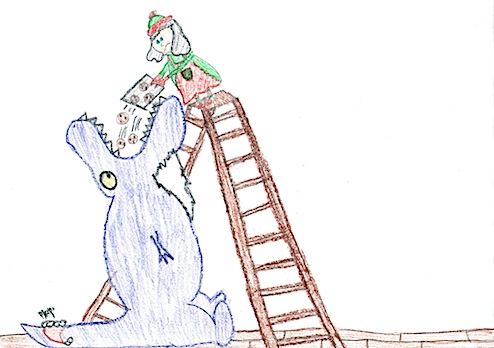
If Santa was a T-Rex…Mrs. Claus would have to do a lot of cooking!
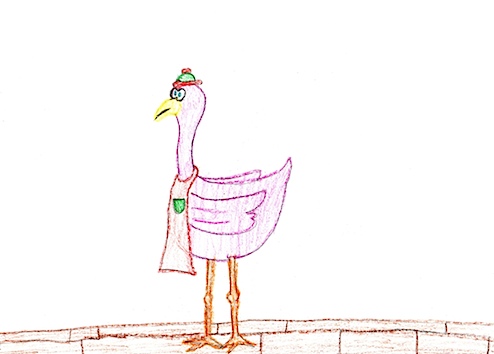
Wait, if Santa was a T-Rex…what would Mrs. Claus be?

If Santa was a T-Rex…what would his elves be?

And if Santa was a T-Rex…what would he give to the kids?…Still toys! …. Just not always the right ones!
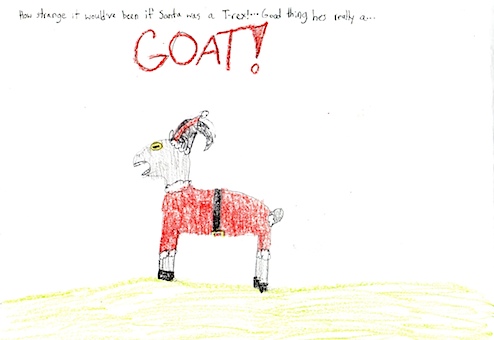
How strange it would’ve been if Santa was a T-Rex! … Good thing he’s really a GOAT!
Comments (33)
12.16.2011 | 10:20 am
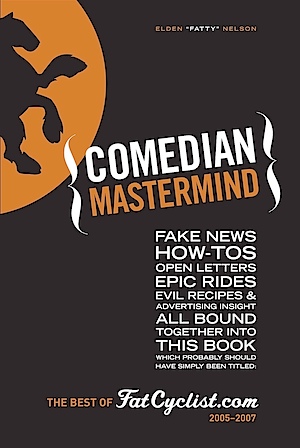 Have you already finished all your Christmas shopping? Awesome! Me too!
Have you already finished all your Christmas shopping? Awesome! Me too!
Oh, yeah. I know. I was just kidding too. I haven’t even started, really.
But!
If you’ve got a cyclist in your life and would like to get that person a copy of my book — Comedian Mastermind: The Best of Fat Cyclist, 2005 – 2007 — for Christmas, well, there’s still (probably) time.
Order today (Friday) or, at the very worst, early Saturday morning, and I’ll promise to do a post office run Saturday. As in, tomorrow.
Based on how fast Media Mail is traveling, you (continental U.S. folk, I mean) really should get your copy before the end of next week. Which is, if I understand my calendar right (and I am right in my calendar reading at least 80% of the time, a good solid B-), still before Christmas.
Now, I don’t know if it really means anything, but quite a few people have emailed and tweeted me after they’ve received and read the book, and everyone seems to be enjoying it.
As in, so far nobody’s sent me an email or tweet saying they’re disappointed in the book and want their money back.
Although, come to think of it, I’ve started a few thousand books in my lifetime, and have probably disliked maybe 10% of those books, and hated maybe an additional 5%. And I’ve never — even once — sent the author an email saying I disliked their book.
But I’ve also — with one exception — never sent an author a note saying I loved her or his book, either.
(That exception, by the way, is Straight Man, by Richard Russo. Anytime anyone ever asks me to recommend a book, I recommend Straight Man.)
Wait a second. How did I wind up plugging someone else’s book? I need to get back on track here.
For more details on Comedian Mastermind, click here.
PS: If you already have purchased and have started reading Comedian Mastermind, I’d be genuinely interested in your leaving a comment here on what you think. Good, bad, or indifferent. I’m thin-skinned, but you won’t see me cry, so it’s OK to be honest.
Comments (53)
12.15.2011 | 12:24 pm
As anyone who has ever tried knows, I am really, really, really good at responding to email. I check my email account several times per day, and quickly respond to each and every message that has been sent my way.
The truth is, the main reason I started writing this blog was because I am great at tactical, logistical stuff like responding to email and organizing events and things. The actual writing of the blog is actually not at all fun for me. If I could, I’d just answer email all day. This is why I most emphatically do not currently have 14,808 unread email messages.
Anyways.
Just yesterday (because I’m totally caught up in my email inbox) I got a message from a reader with an interesting question. I would like to share it with you:
Hi Fatty,
I am reaching out to you because I know you win a lot of races, and so will be able to answer my question from a position of experience and expertise.
My problem is, I never win races, but I would really like to. And I just can’t figure out what I’m doing wrong. I mean, I have a really nice bike. My shorts match my jersey, and they both match my helmet. As do my shoes.
I drink Red Bull, and eat nothing but Hammer Nutrition products.
To top it off, during the race I pedal really hard — so hard that after the race I’m often quite winded!
But I still never win!
Could you please explain what I’m doing wrong, and what I need to do if I want to win a race?
Best Regards,
Duane
I have good news for you Duane, and it’s this: You aren’t doing anything wrong, per se. It’s just that you’re not doing all the right things necessary for someone to win a race.
I believe I can assist you in this matter.
The Missing Ingredient
You mention, Duane, that you have purchased a nice bike, good bike clothes, and even foodlike substances engineered to give you the impression that you are racing.
Those are all good purchases, Duane, and you are to be commended for them.
But even as you have gone about buying things for your race, you have, sadly, neglected the most important — and dare I say most obvious — purchase of all.
You forgot to purchase the race itself.
No, don’t feel bad. You’re not the only one who seems to have forgotten to buy your way onto a podium. In fact, it seems that a startlingly small number of people remember to buy a race, as is conclusively demonstrated by this impressively three-dimensional pie chart:
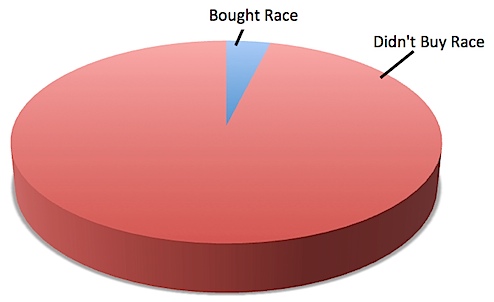
Now, while you may rightly take comfort in the fact that you are not the only one to forget to buy the race, you should also consider the impressive pie chart below:
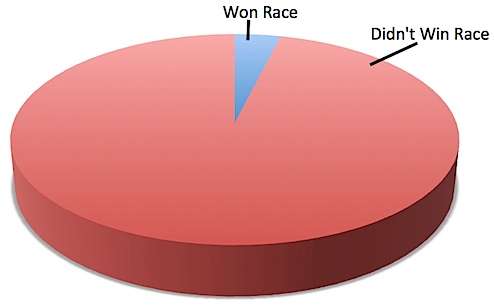
I think you will agree with me that the similarity between the two charts may in fact be more than mere happenstance. And not just because they’re the same chart with different words, either.
Up until now, you clearly have been in the largish “Didn’t buy / Didn’t win” portion of that pie. And that’s OK, don’t feel bad about that. Even in the elite pro ranks, that’s remarkably common. As we have recently learned, however, racers who really care about winning are doing the smart thing: buying the race.
Who Should I Buy It From?
Of course, Duane, the first question you’ll have when buying a race is, “Who do I buy it from?” Well, just like for everything else, you simply go to amazon.com and purchase the race there.
Ha ha! Just kidding, Duane. I’m afraid buying a race is a little more complicated than that.
What you actually need to do is figure out who would win the race on her / his own merits. Write that person’s name down.
Next, assess who would take second. And third. And so forth. Write those names down, too.
In fact, you’d better go ahead and write down the names of everyone who could possibly beat you in this race.
These are the people you need to approach and buy the race from.
How Much Should I Spend?
Once you have found the person from whom you want to buy the race, you need to assess the importance of the race itself, so you can make a reasonable offer. Base prices per person for races are as follows:
- Local or weekly race: $10.00
- Regional race: $20.00
- National race: $50.00
- Grand tour: $9995.00
- Singlespeed World Championships: $1.18
How Do I Conduct the Transaction?
Now we arrive at the most delicate part of this important aspect of winning a race: actually offering to buy it.
The best thing to do is couch the offer in ambiguous terms. The following are all excellent ways to do this:
- The “Happy Coincidence” Approach: “I understand that you like money.” (Wait for response.) “Well, isn’t that a coincidence. I so happen to have some money, and I like winning. It’s almost as if we were meant to be having this conversation.”
- The “Friendly Bet” Approach: “I bet you $20 that I win the race today. By which I mean, of course, if I win the race, you win the bet.”
- The Polite-but-Firm Approach: “Here is some money. Now I would like you to please ride just a little bit slower than I do today. Thank you for your cooperation.”
But What If They Don’t Want to Sell The Race?
In rare circumstances, the person you are talking to will not want to sell you the race. That is unfortunate.
Unfortunate for the person who elected to not sell you the race, I mean. Because you can still buy the race. You just need to find yourself another racer whose “interests” coincide with yours.
And who is not necessarily averse to throwing an occasional elbow. Or to scattering tacks. Or –in rare and desperate circumstances — to having an unfortunate and ill-timed two-bike accident.
What Should I Watch Out For?
When you purchase a race, “discretion” should be your watchword. For example, all of the following ideas are not good:
- Giving a receipt.
- Wearing a jersey that proclaims, “I bought this race.”
- Riding extra slow, just because you’re that confident you’ve got the race in the bag.
- Keeping an email record of your exchange, as well as the hand-wringing that accompanies it.
Follow all this guidance, Duane, and you’ll be well on your way to a long and happy career as a race-winning cyclist.
Happy Winning,

The Fat Cyclist
Comments (24)
12.14.2011 | 10:58 am
A Note from Fatty: If you haven’t checked out the Q&A with Dr. Lim I hosted yesterday, be sure to go back and check it out. The questions were fantastic, presenting a wide range of common on-bike food issues.
Today’s post is also presented by Dr. Lim, because he’s the kind of guy who, when you ask for one favor, instead does three. There’s some great, useful stuff in here. As well as one or two fairly weird things. But I’ll let you find those for yourself.
I decided to check in with a few of my favorite professional riders to see if they had anything to say about avoiding gut rot. Here’s what they had to say.
Craig Lewis (HTC-High Road / Heading to Champion Systems)
In my opinion, Craig Lewis is one of the toughest — if not the toughest — pros in the peloton, having come back from near-death accidents and proving himself as one of the real workhorses on the Pro Tour. At this year’s Giro he crashed and broke his left leg. Later that year, with a rod in his femur, he rode and finished the USA Pro Cycling Challenge in Colorado. Here are some of his thoughts on avoiding gut rot:
- Eat what you’re used to: Don’t try anything crazy or different on your big ride.
- Start eating early: Eat before you’re hungry so you don’t have to eat everything at once. You need to make sure to spread what you eat out over your whole ride rather than making it up when you start to bonk.
- Everything in moderation: Don’t just stick to one food. Eat a variety. Nothing is bad in moderation. It’s when you eat too much of one thing that you start to have problems.
- Avoid too much sugar: When there’s too much sugar in your stomach things start to go bad. So avoid a lot of sugar or make sure you balance it with enough water.
- Stick to foods with really basic ingredients: I like really simple foods and simple bars when I ride. Really basic stuff with all natural ingredients work for me. The simpler the better.
Evie Stevens (HTC- High Road / Heading to Lulu Lemon – Specialized)
Evie Stevens is the current national time trial champion and one of the favorites to represent the United States at the Olympics in London. She’s had a meteoric rise into the pro ranks after giving up her job as a Wall Street associate only 3 years ago. She rarely has many stomach issues on the bike. Here are some of her tips for keeping her belly happy when riding:
- Don’t eat a lot of fiber before a ride: I try to avoid a lot of fiber before training and riding, especially on days when I know there will be a lot of hard efforts.
- Eat real food rather than packaged bars : Sometimes, all we have to eat in races are pre-packaged bars and foods. So I try as much as possible to eat real foods to balance things out, especially in training. One of my favorites is bread with cream cheese and a creamy honey.
- Avoid gels: I mostly eat gummy foods or foods that have a solid consistency when I ride. Occasionally, I might have a gel in a race if I’m desperate, but I don’t like them. They’re messy and gross. I’m fascinated by how people train or race with gels. I can’t really fathom it.
- Figure out what works and what doesn’t: I find that certain foods trigger problems for me. Bananas don’t work for me even though they are pretty popular in cycling. Also, depending on where I am in my monthly cycle, I can be sensitive to certain foods.
Danny Pate (HTC-High Road / Heading to Sky)
With three Tour de France starts and finishes in the last four years, Danny is a pro’s pro, serving this year as a key lead out man for Mark Cavendish. The “Pate,” as he’s affectionately referred to, has one of the strongest stomachs of anyone I’ve ever met. But that doesn’t mean he hasn’t experienced some race-ending gut rot. Here’s his take:
- It’s about moderation: Just like in life, you need to be sensible. You can’t be flying off the handle doing crazy stuff. So don’t overdo it. Some riders are concerned about their weight and try to start light so they don’t eat much before and they have nothing in them. Then they need to eat a ton in the race and that just overloads their stomach.
- Trial and Error: It all comes down to trial and error. You need to figure yourself out. Normally, I can eat or drink anything. I once had 2 liters of Mountain Dew before the Athen’s Twilight and won the “most laps led” competition. Mainly I was just buzzed on sugar and caffeine and was really scared. Anyway, I had no stomach problems — and I almost never have stomach problems. But there are two products that jack me. I won’t mention the brand, but one is a product that other guys have no problem with, but one bite and my race is over. I can eat bags of gummy bears or jellybeans, but I can’t eat this stuff. The other is a particular sports drink. I don’t know what’s in it, but I can’t use it. I have no idea why.
- Those directions weren’t written for you: I think most of the directions on these energy bars and drinks are written to be on the safe side, but they still may not work. You need to write your own directions.
Christian VandeVelde (Garmin-Cervelo)
Christian VandeVelde is one of the top American Grand Tour riders who I’m sure will be a contender at next year’s Tour de France. He’s a legend and one of the most practical and down-to-earth pros I know. Here’s what he thinks:
- Stay away from high fructose corn syrup: Anything with it screws me.
- Stay hydrated: When I get dehydrated I’m busted…every time. But it’s not just about water, it’s about keeping the sugar to water ratio right. Once you get too much sugar and not enough water it’s all over.
- Avoid Gas Station Food: I had a coffee drink and some food from the gas station on the ride today and within half an hour I had the worst gas ever. So do what I say, not as I do, and avoid gas station foods, even though sometimes you can’t do anything else. Just stay away from processed foods and stuff your pockets with real food – a Panini, or bread with jam. Those small packages of SDM are great. If you have that, you can just get water at the gas stations and you’re set.
- Figure out what works for you: It’s all about keeping it simple. For me, the Clif Kid Z Bar is so much simpler than other bars. It tastes great and easy to eat and digest. It’s 130 Calories. One of those bars every half hour and a bottle of sports drink and I’ve got 350 Calories an hour, which is perfect. What I can’t eat when I’m racing are foods with yeast, soy, and dairy. They wreak havoc. If I stay away from those foods then it’s all good across the board.
David Zabriskie (Garmin-Cervelo)
David is one of the only Americans to have one a stage in all three Grand Tours (Giro D’Italia, Tour de France, and the Vuelta). He’s well known for both his blazing time trial speed and his personality. Here are some of his sage words of wisdom:
- Go easy. (Note from Lim: Dave didn’t follow up this comment with anything. He just stopped talking after he said it, and there was an awkward moment of silence. But it’s actually some pretty sage advice. When you’re going really hard, blood flow is shunted away from the gut to working muscle and that makes it hard to digest anything. Often, the rate-limiting factor isn’t one’s heart, lungs, or legs, it’s your stomach. And one of the easiest ways to avoid gut rot is to just go easier or to time your food intake when you are going easy.)
- Avoid crappy food: Anything processed is just bad. Some people out there might be adapting to it, but whatever.
- Keep your diet simple: The simpler you make your diet the easier it is to figure out what doesn’t work and what does work. I mean I could eat nothing but potatoes tonight and tomorrow morning I know I’ll wake up looking terrible. I had all those food allergy tests done and I’m allergic to everything but some things I’m allergic to are fine for me and other things aren’t. So who knows. I just keep things simple so I can hone in on what works.
- I’ll sell my colonic machine for a hundred dollars. (Note from Lim: Again, Dave didn’t follow this up with anything. There was just some awkward silence.)
Taylor Phinney (BMC)
No one in professional cycling has Taylor’s pedigree. And no one in professional cycling has come out with as many major victories as he has in the short time that he’s been racing. At only 21 years of age and in only his first year as a pro, he’s already notched 5 World Championship titles, an Olympic start, and plenty of wins on the track, road, and in time trials. Here’s his simple but to-the-point advice:
- Avoid gels: I’ve never had any terrible stomach problems, but if I do the gels, I’m screwed.
- Eat what works for you: I particular love Almond Snickers as well as homemade rice cakes with pieces of scrambled eggs and bacon.
- Drink: I also try to drink water or a mix with low acidity and a solid amount of salt. For me, drinks like Gatorade have too much sugar and not enough salt.
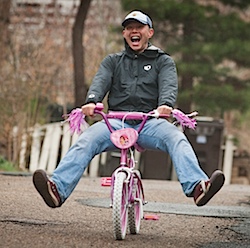 About Dr. Allen Lim: Born in the Philippines to Chinese parents, Dr. Allen Lim grew up in Los Angeles where he learned how to ride at the age of 4 on a pink tasseled bicycle he called “Snow White.” At the age of 13, he earned a Boy Scout Merit badge in Bicycling, riding his bike from LA to San Diego with his brother Almerick and cousin Sean. Soon after, he watched the movie American Flyers and decided that he’d base his future career on Kevin Costner’s character by racing bikes and learning everything he could about sport science. Almost 17 years later he received his doctorate from the Applied Exercise Science Laboratory in the Department of Integrative Physiology at the University of Colorado at Boulder and has been working with professional cyclists ever since. Most recently, with riders like Levi Leipheimer and Lance Armstrong as the director of Sport Science for Team Radio Shack.
About Dr. Allen Lim: Born in the Philippines to Chinese parents, Dr. Allen Lim grew up in Los Angeles where he learned how to ride at the age of 4 on a pink tasseled bicycle he called “Snow White.” At the age of 13, he earned a Boy Scout Merit badge in Bicycling, riding his bike from LA to San Diego with his brother Almerick and cousin Sean. Soon after, he watched the movie American Flyers and decided that he’d base his future career on Kevin Costner’s character by racing bikes and learning everything he could about sport science. Almost 17 years later he received his doctorate from the Applied Exercise Science Laboratory in the Department of Integrative Physiology at the University of Colorado at Boulder and has been working with professional cyclists ever since. Most recently, with riders like Levi Leipheimer and Lance Armstrong as the director of Sport Science for Team Radio Shack.
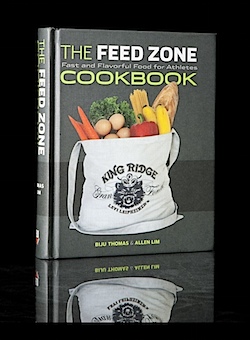 About The Feed Zone Cookbook: Chef Biju and Dr. Lim vetted countless meals with the world’s best endurance athletes in the most demanding test kitchens. Now, in The Feed Zone Cookbook: Fast and Flavorful Food for Athletes, Thomas and Lim share their energy-packed, wholesome recipes to make meals easy to prepare, delicious to eat, and better for performance.
About The Feed Zone Cookbook: Chef Biju and Dr. Lim vetted countless meals with the world’s best endurance athletes in the most demanding test kitchens. Now, in The Feed Zone Cookbook: Fast and Flavorful Food for Athletes, Thomas and Lim share their energy-packed, wholesome recipes to make meals easy to prepare, delicious to eat, and better for performance.
The Feed Zone Cookbook provides 150 delicious recipes that even the busiest athletes can prepare in less time than it takes to warm up for a workout. With simple recipes requiring just a handful of ingredients, Biju and Lim show how easy it is for athletes to prepare their own food, whether at home or on the go.
The Feed Zone Cookbook strikes the perfect balance between science and practice so that athletes will change the way they think about food, replacing highly processed food substitutes with real, nourishing foods that will satisfy every athlete’s cravings.
Comments (15)
12.13.2011 | 9:59 am
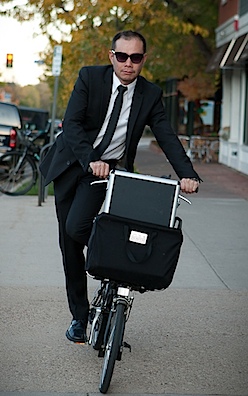 A Note from Fatty About Today’s Post: A week ago or so I posted an interview with Levi Leipheimer. I was interested in the rice cakes he mentioned as one of his favorite riding foods, so I contacted Dr. Allen Lim, asking if he’d share that recipe, along with some tips on how cyclists can avoid “gut rot” — the lousy feeling you get when the food you’re eating during a ride decides it wants out.
A Note from Fatty About Today’s Post: A week ago or so I posted an interview with Levi Leipheimer. I was interested in the rice cakes he mentioned as one of his favorite riding foods, so I contacted Dr. Allen Lim, asking if he’d share that recipe, along with some tips on how cyclists can avoid “gut rot” — the lousy feeling you get when the food you’re eating during a ride decides it wants out.
Dr. Lim was awesome enough to say yes.
Even more awesomely, Dr. Lim said he’d swing by at 4pm (ET) / 1pm (PT) today for a live Q&A, to take questions and give advice on biking and eating. This may be the most useful thing to ever happen on this blog, so be sure to come back to this page this afternoon, and bring your questions!
Avoid Gut Rot on Long Rides
An upset, bloated, or irritable stomach (aka “Gut Rot”) is one of the one of the most common things I hear professional and recreational cyclists complain about on their long rides or races. Though, the triggers for gut rot are different for everyone, one thing is definitive – that no matter how fit you are, a bad belly can stop you dead in your tracks. This is one of the main reasons why Chef Biju Thomas and I wrote The Feed Zone Cookbook and why Dr. Stacy Sims and I developed a secret drink mix for our athletes. With that in mind, here are some tips to help avoid the dreaded gut rot on your long rides.
Listen to Yourself
Because everyone is different the most important piece of advice I give to athletes is to experiment with a wide variety of foods both on and off the bike and to not be afraid to try foods that might buck the trends of today’s sports nutrition marketing.
Something that might really upset one person’s stomach may be the only thing that works for another. For this reason, people often become fervent about their diet or diet system, waving the flag for their favorite gluten free, protein rich, or vegan diet. The contradictions are so stark that it’s easy to be confused by all of the conflicting and seemingly hypocritical advice out there.
But if hypocrisy is the first step to change, then perhaps the most important thing to realize is that if something makes you feel like crap, then change and stop eating or drinking it. So stop overthinking the process and the marketing claims and just listen to your gut.
Make Sure Your Tank is Full
For almost everyone out there, we’ve got plenty of fat on board to literally ride thousands of miles. But without muscle glycogen we can’t easily burn that fat, regulate our blood glucose, or get too far down the road without bonking. So one of the easiest things you can do to avoid a bad stomach on a long ride is to make sure to eat enough carbohydrate in the week leading up to an event to make sure there’s enough glycogen on board so that you don’t have to overload your stomach on the ride just to survive.
Get the Timing Right
Begin eating your pre-ride meal at least 3 hours before start time. For the pre-ride meal, I recommend very simple foods that are filling but not too heavy. A big bowl of oatmeal with a little bit of fresh fruit, nuts, yogurt and eggs works great. Also, try to avoid a lot of fiber before your ride. Chef Biju and I like using a masticating juicer (The Omega 8006 is my favorite) to make fresh squeezed juice using everything from beets to kale in the morning. This helps to increase the nutrient density of the foods we serve without creating a lot of bulk that can fester later in the day.
While on the ride, it’s important to start eating early and consistently. If your ride is longer than 3 hours, try to consume about half the calories you are burning per hour eating something every 20 to 30 minutes and drinking every 15 minutes. That might mean consuming between 200 to 400 Calories an hour depending on your fitness and size and drinking 20 to 60 ounces of fluid per hour. In the end, it’s a lot easier to trickle the fuel and hydration in than to try and shove it all down when you’re starting to hit the wall.
Use Real Food
It has been my experience that most of the pre-packaged energy bars and foods marketed for riding are filled with excess ingredients that end up doing more harm than good. In particular, I find that artificial colors, flavors, and especially artificial sweeteners are absolutely terrible when consumed in excess and during exercise, often causing flavor fatigue, an irritable stomach, and sometimes even acting as a laxative. With that in mind, I advise sticking to simple and real foods. That is, make the effort to prepare some (if not all) of your ride food from scratch, if only to balance the pre-packaged foods that can be hard to avoid because of their convenience and ubiquitous availability.
For many riders I know, this literally means taking a little rice cooker, an electric pan and a few cooking utensils with them when travelling to rides or race events. With these simple tools and a nice paper foil like Martha Wrap™ (available from Amazon or at Safeway) to wrap your food, you can make a host of ride foods like sushi rice cakes mixed with eggs and bacon (recipe at the bottom of this post), or little boiled potatoes drizzled with a little olive oil, salt, and Parmesan cheese. Other real food ride favorites include waffle sandwiches filled with cream cheese and jam or little Hawaii rolls filled with a piece of salty meat and jam, or a tortilla with a sweet and salty almond butter and honey spread.
Many of these portable recipes can be found in The Feed Zone Cookbook that I co-wrote with Chef Biju Thomas (http://feedzonecookbook.com/).
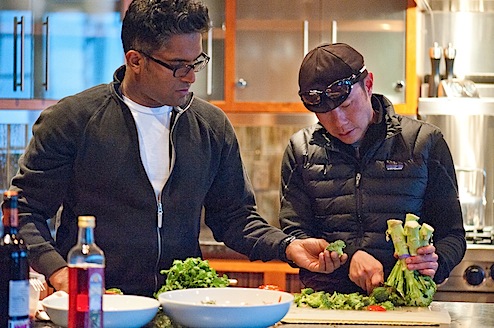
Stay Hydrated First
For many riders, a lot of the stomach problems they have are solely caused by a lack of fluid intake. One of the easiest ways to make sure that you are getting enough fluid is to weigh yourself before and after a ride to learn how effort and environment affect your fluid needs. Make it a goal not to lose more than 3% of your body weight over the course of a ride.
Beyond fluid intake, it is also imperative that you replace sodium while exercising. Since we can lose a lot of sodium during exercise (300 to 700 mg per hour depending on sweat rate) if all we drank was water to replace the fluid loss, we would be diluting the sodium in our body. Since, sodium plays a critical role in our bodily function, a decrease in sodium or hyponatremia can do more it than hurt our performance – it can kill us.
To that end, a simple sports drink with a plenty of sodium (300 to 400 mg per 16 ounces) and little bit of sugar (e.g., 70 to 80 Calories per 16 ounces) to help with absorption and to stabilize blood sugar is critical. Because it was almost impossible to find a very simple sports drink that fit these needs while not being laden with artificial flavors, colors, or sweeteners, we developed our own all natural exercise mix for riders competing in the Tour de France that they secretly replaced their sponsors drink with and that helped them alleviate race debilitating gut rot (www.secretdrinkmix.com).
Separate Hydration and Fuel
In my experience the one absolute recipe for gut rot is when athletes try and drink their calories. Anything more than 80 to 100 calories in a standard small water bottle and you’re asking for trouble. This also means avoiding gels if possible or having at least one bottle of water to drink with the gel if you’re going to use it and/or only using gels when you’re close to the finish. I think that one of the biggest misnomers is that our fuel needs to be pulverized like baby food for it to be easily absorbed. The reality is that eating solid foods that form a bolus in your stomach makes it easier for fluid to pass around that food assuring that the fluid in your stomach empties while the fuel slowly digests and absorbs without impeding hydration and causing the dreaded stomach bloating.
Savory Sushi Rice Cakes
These rice cakes are one of Levi Leipheimer’s favorite ride foods.
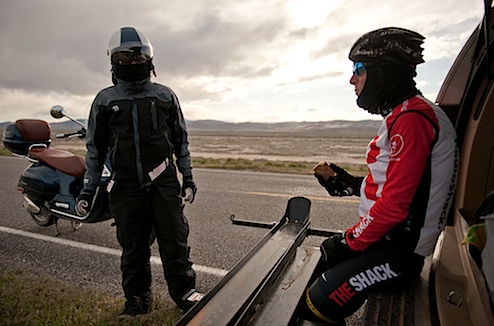
They’ve become a staple for the riders I work for and a great balance to all the sweet foods that are normally available during training camps and long stage races. At the Tour de France, I’d make about 40 or so cakes every morning in my hotel room using a rice cooker and an electric frying pan. They’re tasty, easy to eat and, most importantly, they’re easy on the stomach.
Ingredients:
- 2 cups uncooked calrose or other medium-grain “sticky” or sushi rice (never use Basmati as it won’t stick.
- 3 cups Water
- 8 ounces of bacon (prosciutto or sausage or even roasted chicken also works great)
- 4 eggs
- 4 tablespoons (or flavor to taste) of Braggs liquid Aminos (all natural soy sauce) or a low-sodium soy sauce
- 4 tablespoons (or flavor to taste) of brown sugar
- Salt and grated Parmesan (optional)
Directions:
- Combine rice and water in a rice cooker. Start rice cooker. If using a standard pot, combine rice and water, bring to a boil, then let simmer on low for about 20 minutes.
- While rice is cooking, chop up bacon before frying, then fry in a medium sauté pan. When crispy, drain off fat and soak up excess fat with paper towels.
- Beat the eggs in a small bowl and tehn scramble on high heat in the sauté pan. Don’t worry about overcooking the eggs as they’ll break up easily when mixed with the rice.
- In a large bowl or in the rice cooker bowl, combine the cooked rice, bacon, and scrambled eggs. Add liquid aminos or soy sauce and sugar to taste. After mixing, press into an 8- or 9-inch square baking pan to about 1 ½ inch thickness. Top with more sugar, salt, and grated Parmesan if desired.
- Cut and wrap individual cakes in a paper foil like Martha Wrap™. Makes about 10 cakes.
Nutrition Information Per Serving (1 Cake):
Energy – 225 Cal
Fat – 8 g
Sodium – 321 mg
Carbs – 30 g
Fiber – 1 g
Protein – 9 g
 About Dr. Allen Lim: Born in the Philippines to Chinese parents, Dr. Allen Lim grew up in Los Angeles where he learned how to ride at the age of 4 on a pink tasseled bicycle he called “Snow White.” At the age of 13, he earned a Boy Scout Merit badge in Bicycling, riding his bike from LA to San Diego with his brother Almerick and cousin Sean. Soon after, he watched the movie American Flyers and decided that he’d base his future career on Kevin Costner’s character by racing bikes and learning everything he could about sport science. Almost 17 years later he received his doctorate from the Applied Exercise Science Laboratory in the Department of Integrative Physiology at the University of Colorado at Boulder and has been working with professional cyclists ever since. Most recently, with riders like Levi Leipheimer and Lance Armstrong as the director of Sport Science for Team Radio Shack.
About Dr. Allen Lim: Born in the Philippines to Chinese parents, Dr. Allen Lim grew up in Los Angeles where he learned how to ride at the age of 4 on a pink tasseled bicycle he called “Snow White.” At the age of 13, he earned a Boy Scout Merit badge in Bicycling, riding his bike from LA to San Diego with his brother Almerick and cousin Sean. Soon after, he watched the movie American Flyers and decided that he’d base his future career on Kevin Costner’s character by racing bikes and learning everything he could about sport science. Almost 17 years later he received his doctorate from the Applied Exercise Science Laboratory in the Department of Integrative Physiology at the University of Colorado at Boulder and has been working with professional cyclists ever since. Most recently, with riders like Levi Leipheimer and Lance Armstrong as the director of Sport Science for Team Radio Shack.
 About The Feed Zone Cookbook: Chef Biju and Dr. Lim vetted countless meals with the world’s best endurance athletes in the most demanding test kitchens. Now, in The Feed Zone Cookbook: Fast and Flavorful Food for Athletes, Thomas and Lim share their energy-packed, wholesome recipes to make meals easy to prepare, delicious to eat, and better for performance.
About The Feed Zone Cookbook: Chef Biju and Dr. Lim vetted countless meals with the world’s best endurance athletes in the most demanding test kitchens. Now, in The Feed Zone Cookbook: Fast and Flavorful Food for Athletes, Thomas and Lim share their energy-packed, wholesome recipes to make meals easy to prepare, delicious to eat, and better for performance.
The Feed Zone Cookbook provides 150 delicious recipes that even the busiest athletes can prepare in less time than it takes to warm up for a workout. With simple recipes requiring just a handful of ingredients, Biju and Lim show how easy it is for athletes to prepare their own food, whether at home or on the go.
The Feed Zone Cookbook strikes the perfect balance between science and practice so that athletes will change the way they think about food, replacing highly processed food substitutes with real, nourishing foods that will satisfy every athlete’s cravings.
Comments (34)
« Previous Page — « Previous Entries Next Entries » — Next Page »















 About
About 

